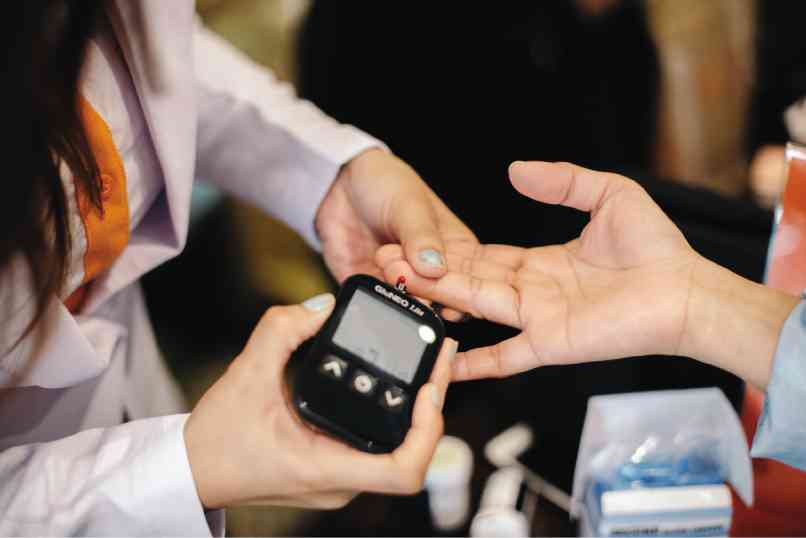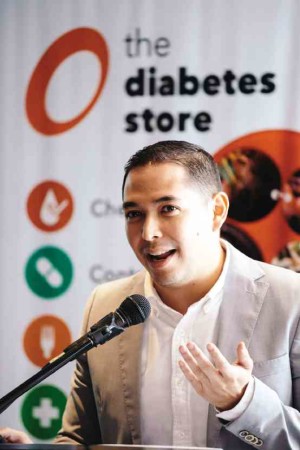Diabetics find helpful partner in specialty store

AMONG the products at The Diabetes Store is a glucose meter, which returns results in as fast as 5 seconds.
“The Diabetes Store” (TDS) is an unequivocal name, but that’s exactly what this new shop wants the Philippines—a diabetes hotspot—to know at once.
TDS, the first one-stop-shop for diabetics in the Philippines, does not want to lose time in the battle against a leading cause of mortality.
“Our goal,” said general manager Jose Ramon Syquia Felix, “is all about supporting the management of the patients and their progress. In the store, we shall accommodate and address all the lingering questions that diabetic patients may have.”
They want to target an enormous market of some 8 million Filipinos, growing by 500 each day.
The TDS concept was born after selling only one item, said Felix.
“We began in the business by distributing the cheapest glucose monitors … to hospitals, laboratories, and we saw the growing concern,” he said.
Their concept turned into an Internet-based business and, with partners that include his own diabetic father, now into a new physical store.
The Parañaque City store, open every day from 10 a.m. to 8 p.m., is manned by diabetes educator Alyssa Luminarias, also a registered nutritionist-dietician.
“She’ll provide a health plan on their diet, exercises appropriate for each diabetic patient, remind you about your next doctor’s appointment and keep tabs on your medicine,” said Felix.
TDS wants to be omnipresent in one’s bout against diabetes, unfortunately still incurable. To do that, it uses an outline encompassing a diabetic’s life, “The 5Cs of Diabetes”—check, control, consume, care, counsel.
For check, the store sells some of the most affordable devices in the market to monitor one’s health, claimed Felix. It has blood pressure monitors and glucose meters. TDS also has on-site testing for blood sugar and cholesterol.
Control presents TDS’ oral medicines and insulin shots.
Consume shows sweeteners, beverages, sweets, ready-to-eat meals, even a meal measure plate. The best-seller, noted Felix, is ice cream with coco sugar. Ready-to-eat meals can be planned through a meal nutrition plan, factoring in caloric intake and health conditions to make a diet plan that can go from a week to a month.
Under care, TDS offers special accessories for diabetics, such as heel protectors, insoles and socks.
The diabetes educator is at the center of TDS’ services under counsel. Trained by the Institute of Studies in Diabetes Foundation (ISDF), Luminarias administers tests. In a one-on-one setting, she can also conduct module-based counseling.
TDS partnered with multiple brands for the items it sells and produces some of them. It did not abandon its online presence, so people can order items through its website and pay via credit cards, PayPal, bank deposits, and cash-on-delivery for Metro Manila and nearby provinces.
The growth from the Web into a physical store, like its development process for its offerings, is guided by TDS’ philosophy.
TDS, its slogan notes, is “diabetes made friendly,” and part of that mission is to be more personal, noted Felix.
“We’re more than just a transactional outlet,” he said.
With that, TDS also has community-building efforts for diabetics. It wants to hold monthly forums in the store and elsewhere, where diabetics can share tips for diets, exercises and more. “Here, the goal is to generate a collaborative community of diabetic patients,” said Felix.
TDS also maintains online communities and even answers questions via social media. They also entertain home servicing.
Services are tailored not just for Type 1 and Type 2 diabetics, but also for what TDS calls the “Type 3,” the caregivers.
According to Dr. Danilo F. Baldemor, a diabetologist and professor at ISDF, a diabetic has a whole community helping out. It includes the doctor, the nurse and diabetes educator, the nutritionist-dietician, pharmacological companies, family, even coworkers or neighbors. They also face constant pressure.
Much of the pressure is financial, said Dr. Ma. Cecille Añonuevo-Cruz, specializing in endocrinology and internal medicine.
In 2015, people worldwide spent $673 billion for diabetes and related conditions.
According to the International Diabetes Federation, each diabetic Filipino spent $482 in 2015 for diabetes care, and that’s a “modest estimate,” she claimed.
“Patients would need not just one medication but several in order to maintain their blood sugar and, likewise, their cholesterol and blood pressure levels,” she added.
Cruz shared an estimate for expense on medications, which is P31,755 a year. That does not include costs for complications—Baldemor said diabetes can double or quadruple the chance of heart disease, and is the No. 1 cause of blindness and end-stage renal disease that leads to dialysis.
TDS helps manage some of the load from the “Type 3.” It carries some affordable options; items priced at par with supermarkets and drugstores in just one place; discounts and incentives for members.
Through monitoring and encouraging patients, it helps fend off complications.
TDS has other markets to generate income from.
Its product line can help patients suffering from hypertension and other complications, even if they do not have diabetes. The fitness boom can contribute to sales, with more and more consuming healthier alternatives. Pre-diabetics are advised to do what diabetics do, so TDS can be a go-to.
TDS held its formal opening only this March, but it already aims for higher things, said Felix.
More diabetes educators will be hired soon. Felix wants TDS to find more and cheaper local sources for its products, and is also in the process of importing items.
He wants to see the TDS logo on diabetic-friendly entrees, in an effort to improve brand alliances with restaurants and gyms.
TDS aims for a second branch in northern Metro Manila soon, Felix said.
It also wants to benefit from the Asean integration, looking to introduce the brand elsewhere in the region in the next three years, all in the name of helping diabetics.

